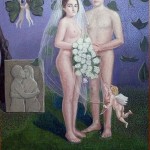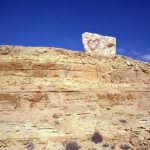Hmmmm, one of those weird, “cue the Theme from the Twilight Zone” moments.
Maybe this is something everyone else already knows, but I didn’t know it. In fact, I just figured it out for myself.
So, I’m either a genius, or just so unstudied that to further remark would be pathetic.
I’m figuring the latter.
But it occurred to me this morning that we Christians take great refuge in John 3:16:
For God so loved the world that he gave 7 his only Son, so that everyone who believes in him might not perish but might have eternal life.
Did we realize that the passage perfectly, succinctly answers the great brokenness that occurred in Genesis 3:1-6?
Now the snake was the most cunning* of all the wild animals that the LORD God had made. He asked the woman, “Did God really say, ‘You shall not eat from any of the trees in the garden’?” The woman answered the snake: “We may eat of the fruit of the trees in the garden; it is only about the fruit of the tree in the middle of the garden that God said, ‘You shall not eat it or even touch it, or else you will die.’” But the snake said to the woman: “You certainly will not die!b God knows well that when you eat of it your eyes will be opened and you will be like gods, who know* good and evil.” The woman saw that the tree was good for food and pleasing to the eyes, and the tree was desirable for gaining wisdom. So she took some of its fruit and ate it; and she also gave some to her husband, who was with her, and he ate it
I was given to think about Genesis, and that passage, after reading this piece last night, and on Simcha Fisher’s Facebook thread, a long — eventually pretty raucous — discussion on the essay. The discussion of modesty and chastity eventually lead to a discussion of how we teach the value of chastity without becoming such idolators of the hymen that we wound our children. (And yes, that happens; my own family members still bear the scars of a virginity-obsessed mad patriarch.)
And that discussion lead me to recall this piece on Genesis, sin and yes, the hymen I’d written a few years back:
The taint of Original Sin: God has been trying to get us to trust Him, to reveal ourselves to Him and to be vulnerable (open) to Him ever since.
Perhaps this explains the command by God for the Jews to circumcise the men. The foreskin of the penis affords some protection for the organ – a bit of shelter, a place to hide. When God chose the Jews as His own, he required this symbolic (and real) acquiescence – this willingness to be completely vulnerable and exposed to whatever may come. The unsheathed penis is sensitive and responsive and exposed – precisely the qualities God wanted of the Jews. He made a covenant with them; He would be their God, they would be His people, and the deal was sealed in blood. At its shedding, man and God are bonded.
The need to be vulnerable and open to God is part and parcel of having a real relationship with Him, just as it is the necessary component in human relationships. We see the blood covenant and the need for vulnerability and openness mirrored in the relationship between a husband and wife – or we did, when virginity was kept for marriage. The thin membrane of the hymen is a kind of counterpart to the foreskin. In shedding the foreskin the Jew becomes openly vulnerable to God. In remaining a virgin until marriage, the woman becomes vulnerable only (but fully) to her husband, and he – in receiving that vulnerability – answers only to her, gives his deepest self and the sweat of all of his labors to her. It is another blood covenant. At the shedding of that blood, they become one flesh. One entity.
Why do we not know that? Why is it never taught that way? For centuries and centuries virginity was little more than a premium – a selling point for chattel – and even today, in some cultures, that idea remains.
God says, “be my people,” and there is a blood covenant. A man and woman say “be mine” and there is a blood covenant. We have never understood.So God becomes Incarnate and tries to explain: “be opened. I will show you how. I will make myself vulnerable to you. You may have my blood. It is shed for you and for all so that sins may be forgiven.”
It is the greatest of the blood covenants, because the blood covers and draws into oneness not a tribe, nor a mate, but an entire creation – for better or worse. The marriage of heaven to earth, God to man.
Looked at this way all of the dogmas no longer seem trite. . . God could not make Himself any more vulnerable than to come to us – through a woman, of her blood, then laying in a wooden manger — and to go from us hanging upon the wood of a blood-soaked cross. He rose and said “see, I make all things new – even death cannot separate us. Come to me.”
Christ has opened God to us, through Himself. God does the unthinkable and makes himself vulnerable and says “Come. . .stop making excuses, stop hiding yourselves, stop blaming others, stop throwing yourself away, stop running from my love. Turn and face me. Ephphatha, be opened, and let me love you, let me give myself to you as you give yourself to me, and this will bear fruit.”
Seen in this light, all of those “stale, repressive, outdated ideas” about chastity and virginity become infused with an entirely different meaning than the “good girl, pure girl/bad girl, slutty girl” paradigms our society both entertains and rejects, but can never fully move past, because of our human habit of conceptualism. Suddenly our understanding of purity (for men and for women) aligns with the bottomless mystery of Christ the Bridegroom, the Person of God, wedded to his creation in everlasting covenant. And even within the depths of that profound theology, there is no room for either slut-shaming or lazy coarseness.
Of course, The Gospel of John also mirrors Genesis in its opening passage — the one which you know fascinates me endlessly:
In the beginning was the Word,
and the Word was with God,
and the Word was God
He was in the beginning with God.All things came to be through him,
and without him nothing came to be.b
What came to be
through him was life,
and this life was the light of the human race;
It sings right along with the the first Creation narrative.
Beginnings of worlds and of covenants — the mysteries of intention and affirmatives — anything going forward originates on the “Yes”, whether it is God’s “Let there be…” or Mary’s “let it be…”
Good heavens, even this photo of a core galaxy via Hubbell suggests nothing so much as an ova on the cusp of fertilization:
So, so much — so very much — to think about and ponder and pray on, and so little time. “Our life is over like a sigh. Our span is seventy years, or eighty for those who are strong.”
Absent a retreat, which I dearly need, and which would give over some of that needed time, I think I will spend this Lent reading Genesis and the Gospel of John, side-by-side, to see where else they align with each other, like a call-and-response, ever ancient, ever new.
UPDATE: Wow, I love This piece by Michah Murphy; it is a great warm up to the Lenten idea!
Related:
Setting the World Ablaze!












